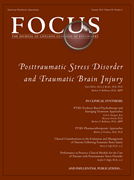Prevention and Early Intervention: PTSD Following Traumatic Events
Abstract
Clinical Context
| Variables to Consider After Trauma Exposure |
|---|
| Sleep quality before and after trauma |
| Trauma type (intentional or not) |
| Peri-traumatic tonic immobility |
| Perceived sense of threat |
| Perceived self efficacy |
| Cognitive flexibility |
| Perceived/anticipated support/help |
| Social support before during and after |
| Family/social unit cohesion |
| Initial PTSD symptoms: psychological and physiological distress |
| Post trauma cognitive factors: how one remembers and thinks about it |
| Heritable risk: personal and family history of psychiatric, alcohol and drug problems |
| Childhood adversity/trauma |
| Predictors of future trauma: personality, alcohol, drug use, patterns of services use |
| Meaning attached to trauma experience |
| Parental stress related to child wellbeing |
| Prior perceived trauma (not exposure to potentially traumatic events) |
| Sense of control: over especially grotesque events and perceived threat |
| Negative emotionality |
| Cognitive appraisal style |
| Exposure characteristics |
| Personality factors |
| Difference score on a 0–10 scale of distress at emergency department (ED) admission versus leaving the ED/discharge |
| Difference score on a measure of how upset a patient was in the ED assessed 24 hours later, and how they feel several days or weeks later |
Treatment Strategies and Evidence
Pharmacological Treatments
Psychological Debriefing
Brief Psychosocial Interventions
Cognitive Behavioral Interventions
Early Intervention for Trauma-Exposed Individuals in the Emergency Department
Questions and Controversy
Recommendations From the Authors
Footnote
References
Information & Authors
Information
Published In
History
Authors
Funding Information
Metrics & Citations
Metrics
Citations
Export Citations
If you have the appropriate software installed, you can download article citation data to the citation manager of your choice. Simply select your manager software from the list below and click Download.
For more information or tips please see 'Downloading to a citation manager' in the Help menu.
View Options
View options
PDF/EPUB
View PDF/EPUBGet Access
Login options
Already a subscriber? Access your subscription through your login credentials or your institution for full access to this article.
Personal login Institutional Login Open Athens loginNot a subscriber?
PsychiatryOnline subscription options offer access to the DSM-5-TR® library, books, journals, CME, and patient resources. This all-in-one virtual library provides psychiatrists and mental health professionals with key resources for diagnosis, treatment, research, and professional development.
Need more help? PsychiatryOnline Customer Service may be reached by emailing [email protected] or by calling 800-368-5777 (in the U.S.) or 703-907-7322 (outside the U.S.).

